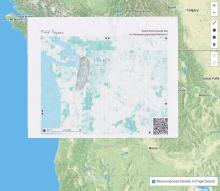The Geography department’s GEOG 381 class is helping to combine the study of maps, GIS, and other geovisualization technologies with research on the geography of health. Skye Naslund, the instructor of the course, has had her students design health atlases on a topic of their choice while utilizing a variety of mapping technologies. By using programs like ArcMap, GeoJSON, Field Papers, and even traditional hand drawn maps, students are getting an introduction to key geovisualization tools.
For example, Sean Fisher, one of the students enrolled in the class, was able to use ArcGIS to map out where Lime Disease is most prevalent in the United States. By using various choropleth maps, cartograms, and other mapping styles, Sean was able to show that Lime Disease is disproportionally found in the Northeast, particularly in the habitat of the deer tick.
Alex Carl took a similar approach, except he decided to create an atlas of Multiple Sclerosis (MS). He found that MS was extremely common in northern parts of the country, particularly in the Puget Sound area. By intersecting various types of mapping programs with his health data, Alex was able to visualize a health concern that is quite literally in our own back yard.
While each of these individuals' work is a great representation of what students have been doing in Skye Naslund's class, one of the more noteworthy features of the class is the makeup of the students enrolled. Consisting of a combination of geography majors, public health majors, and assorted others, the class allows students to be exposed to alternative viewpoints from their peers. What a traditional geographer might consider important in the field of map making may not always take into account certain social situations that a public health major may have experience in. Having that sort of crossover allows students to better reflect intellectually on health maps through the lens of critical social theories about power and knowledge.
